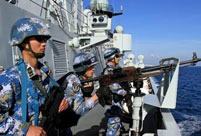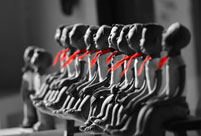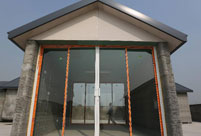 Cherry blossoms reach peak bloom in Washington D.C.
Cherry blossoms reach peak bloom in Washington D.C.
 Top Chinese fashion icons in foreigners' eyes
Top Chinese fashion icons in foreigners' eyes
 Asia's largest business aviation exhibition to be held in Shanghai
Asia's largest business aviation exhibition to be held in Shanghai
 World's top-rated luxury hotels
World's top-rated luxury hotels
 Wu Jing, Xie Nan to hold wedding on May
Wu Jing, Xie Nan to hold wedding on May
 London Cake International attracts tourists
London Cake International attracts tourists
 Let's dance in harmonic Shaanxi
Let's dance in harmonic Shaanxi
 Christie's to auction dazzling diamonds
Christie's to auction dazzling diamonds
 'Model husband' shatters image of love
'Model husband' shatters image of love
 Can animals smile? Or put on a happy face
Can animals smile? Or put on a happy face
SYDNEY, April 17 -- The agonizing search for the vanished Malaysian Airlines flight MH370 and its equally confounding black box is now reaching into seemingly inaccessible depths, with the best technologies reaching their limit this week.
With the Southern Ocean throwing even more challenges in the now desperate race against hope, authorities have begun to acknowledge that the black box has reached its use by date and new, desperate measures are now in place.
By mid-week, far off the coast of Western Australia, the latest roll of the dice for an international operation spanning more than 20 countries that have thrown everything in the search for the fateful Malaysian Airlines Boeing 777 witnessed the "Bluefin-21" autonomous vehicle slide into the ocean.
At about the same time, experts around the world announced that in all likelihood, the final breaths of the Boeing's black box were being taken somewhere at the bottom of an ocean dotted with underwater volcanic activity and perilous topside conditions.
Several days later and it appears that the submersible bluefin may have already pushed beyond its own limits.
Problems lingered over both days of operation, with the bluefin reaching its maximum operating depth of 4.5 kms and authorities declaring "no objects of interest" from its first, brief 7 hour search.
Authorities have little choice but to engage in a visual search in the area 2,087 km north west of Perth, that assumes the black box and any debris is languishing in depths beyond our best technology, in relentless dark and a quagmire of sediment.
Much debate has surrounded the shelf-life of the black box, what Australian aviation expert John Faulkner calls an Australian invention. The black box recorder beacon batteries last a minimum of 30 days.
Flight MH370 vanished over the South China Sea some 40 days, and for many, a lifetime ago.
That leaves technology referred to as "side-scan" type sonars, in-built on the bluefin autonomous vehicle, in search now for the wreckage of the plane itself.
Although not as the name implies, the actual black boxes are not necessarily black, but simply too small to find.
Faulkner said, "The first black boxes were initially produced in the UK with acknowledgment of its Australian origins but these acknowledgments soon disappeared.... In 1965, cockpit voice recorders were mandated in all commercial aircraft built in the US and the western world followed."
Faulkner, a Senior Visiting Fellow at UNSW, has been at the heart of Australian aviation and his insights into the challenges facing MH370 searchers have provided some light - and sobriety - in an emotion charged month that has seen the largest maritime search in history launched off the coast of Perth.
Robin Robertson, a Senior Lecturer at ADFA (Australian Defence Force Academy) said that to locate underwater objects in an ocean, such as the location beacon "pingers" attached to the black boxes of MH370, sonars will now be the best "shot in the dark".
"If and when the search underwater resumes, there are a number of challenges. Since light only penetrates to about 200m deep even in the clearest water, light is not so useful for searching in the ocean."
Robertson said multi-beam and side-scan sonars determine the depth of the ocean and the thickness of different types of sediment, such as mud or sand.
"But the depth of the ocean is not well known. We know the Moon and Mars better than we know the ocean floor."
Search coordination from the ADV Ocean Shield has limits in an area almost totally unmapped.
And that vast ocean has turned out to be deeper than expected.
According to Robertson, "They discontinued using the autonomous vehicle, since it needs to be within 30m of the ocean bottom to work properly and that now appears to be beyond its depth range."
At such depths, pressure becomes a factor, and technology is yet to be created that can endure long-time operation.
Pressure increases by about 1 atmosphere of pressure for every 10m descent (one atmosphere is about 1 kg per square centimeter or 14.7 lb per square inch). At 4,500 meters there would be 450 more atmospheres of pressure. Equivalent to about 465 kg of pressure per square centimeter, according to Robertson's calculations.
It's estimated the search area as roughly 75,000 square kilometers, larger than the nation of Belgium.
Frustration and anxiety have marked an extraordinary international effort that has spanned across the Asia-Pacific over 40 days.
Even last month, putting some perspective on the geographical challenges, the Vice Chief of the Australian Defense Force (ADF), Air Marshal Mark Binskin told reporters, "We are not searching for a needle in a haystack."
"We are trying to define where the haystack is."
 A bite of China II whets the appetite
A bite of China II whets the appetite Chinese frigate completes its 14th escort mission
Chinese frigate completes its 14th escort mission Let's dance in wealthy Shaanxi
Let's dance in wealthy Shaanxi A date with 798: feel the art around you
A date with 798: feel the art around you 3D-printed houses built in Shanghai
3D-printed houses built in Shanghai World largest scale of umbrella dance
World largest scale of umbrella dance Cherry blossoms reach peak bloom in Washington D.C.
Cherry blossoms reach peak bloom in Washington D.C. Red terraced fields in Dongchuan of Yunnan
Red terraced fields in Dongchuan of Yunnan Presentation ceremony of 33rd Hong Kong Film Awards
Presentation ceremony of 33rd Hong Kong Film Awards The backstage of the Fashion Week
The backstage of the Fashion Week College students in Han costumes
College students in Han costumes Postgraduate works as waitress
Postgraduate works as waitress Life in a Lahu village in Yunnan
Life in a Lahu village in Yunnan An orphan’s wedding
An orphan’s wedding Hollywood documentary brings Diaoyu Islands truth to new audience
Hollywood documentary brings Diaoyu Islands truth to new audienceDay|Week|Month